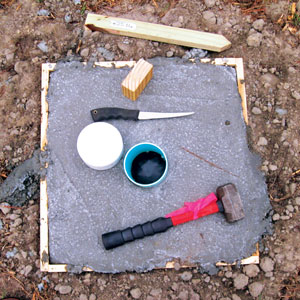
Treatment and concrete were completed for this plot on the previous day. The filet knife will be used to remove the vapor barrier from within the PVC tube and the wood block placed inside. Finally, the cap will be placed on the tube and the identification stake hammered in the ground just above the concrete frame. PHOTO: U.S. Department of Agriculture Forest Service
Candidate insecticide products under consideration for use as soil termiticides are required to have specific efficacy data for federal registration by the U.S. Environmental Protection Agency (EPA). Data that are collected annually by the U.S. Department of Agriculture (USDA) Forest Service (FS) Forest Products Laboratory (FPL), Durability and Wood Protection research work unit (RWU 4723), serve to fulfill this need. The FS group installs and evaluates wooden test pieces on plots of soil treated with candidate termiticide products. Data from these studies are used in the registration process to determine acceptable application concentrations for the marketed product label.
This annual report shows the current study data for soil termiticide products that have reached federal registration. Data provided are limited to label-approved rates of application for these products. This provides information for both pest management professionals (PMPs) as well as homeowners. Because the FS observes some plot locations late in the calendar year, data collected from the previous year (2022) are reported in this publication.
We have collected termiticide data since 1938 on plots located at the Harrison Experimental Forest near Gulfport, Miss. This location has remained a constant and active part of this program, whereas other locations have expanded and contracted over the years. The following sites are currently in use:
- Chipola Experimental Forest in northwestern Florida.
- Harrison Experimental Forest in southern Mississippi.
- Calhoun Experimental Forest in western South Carolina.
Because only native subterranean termite species belonging to the genus Reticulitermes occur at these sites, our test data only apply to members of this genus.
Program status
In 2022, no new products were installed at the FS termiticide testing sites, and two ongoing candidate termiticides were evaluated. In March 2023, a study was installed for a new compound at the Chipola Experimental Forest. This was the first new candidate product to be installed since 2017. The tables included in this report provide data for current federally labeled termiticides in the U.S. (see p. 47 of Pest Management Professional’s May 2015 issue). Manufacturers of these candidate products can withdraw them from testing for any reason. It is our policy to not report on products that do not obtain federal registration; therefore, no withdrawn products or EPA-rejected products appear in the tables of this report. This prevents confusion and possible off-label use of agricultural products that contain the same active ingredients.
General methods
The FS termiticide testing program provides data as an unbiased third-party on the efficacy of candidate termiticides in cooperation with the tested product’s manufacturer. Collected efficacy data is used for eventual inclusion in a registration packet submitted to the EPA when seeking federal registration. Tests are initiated when a potential cooperator brings a candidate product to our unit with the chemical concentration series they are interested in examining. Cooperator personnel can observe and assist to a limited extent with the study. General assistance such as digging holes or clearing trees from a plot area is acceptable. Help from the cooperator with mixing product, treating plots, and determining wood block damage (reading) is not allowed. The RWU 4723 personnel who mix and apply candidate chemicals have current commercial pesticide applicator certificates and many years of experience with the test protocol.
The FS protocol offered includes installation and annual reading of plots using the ground board, concrete slab and stake methods, as well as residual pesticide soil sample collection. Both the ground board and concrete slab methods are tests for soil barrier efficacy; the stake method is a slightly different barrier test for wood embedded in treated soil and has not been requested for decades.
These three methods are identical to those required by the EPA Office of Poisons, Pesticides and Toxic Substances (OPPTS) 810.3600 document. This document requires five years of efficacy data for candidate termiticides. In total, from product installation to completion, these studies take six years to complete. Annually, we provide product manufacturers with updates on their product’s performance. The EPA, as well as state regulatory agencies (once the product obtains federal registration) are free to contact the FS regarding the data or methods used to obtain them.
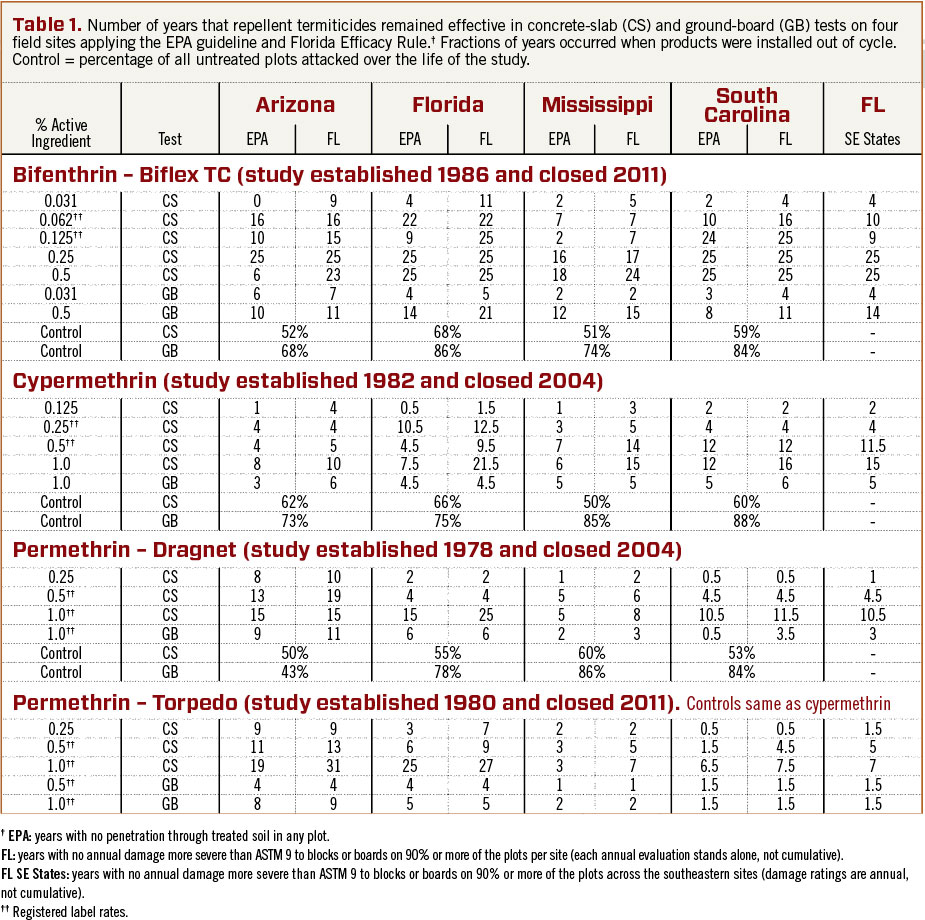
Editor’s Note: For the charts above and Table 2, the data for the program that can be made public at press time have remained the same since they were first printed in the March 2015 issue of Pest Management Professional magazine. Please note the inclusion of brand names and manufacturer names are for data purposes only, and does not imply endorsement by the USDA-USFS.
Ground board test
The ground board test and the modified ground board (or concrete slab) test are specified for efficacy testing of candidate products in OPPTS 810.3600. Ten replicates of each concentration (including water-only controls) are installed for each candidate termiticide in each of three experimental forests as described above.
The methods are described in the annual termiticide report each year (see p. 60 of PMP’s May 2017 issue, and all earlier FS annual termiticide reports). Because no procedural changes have been made, the language used to describe them remains relatively constant.
The ground board test employs a 24-by-24-inch area that is cleared of debris, roots and rocks. Next, a 17-by-17-inch area is treated with the candidate termiticide. After drying, a 6-by-6-inch square pine sapwood board is centered on the exposed, termiticide-treated soil, and held in place with a brick.
Concrete slab test
The concrete slab test is similar to the ground board test. In this test, a 24-by-24-inch area is cleared and prepped as described above. A 17-by-17-inch area is treated as in the ground board test. After treatment, the soil is covered by a polyethylene vapor barrier, and a 21-by-21-inch concrete slab is poured around a 4-inch diameter polyvinyl chloride (PVC) pipe placed at the center of the square.
Once the concrete has set, the vapor barrier is cut out and removed from the bottom interior of the PVC pipe, and a 3.5-by-2.5-by-1.5-inch rectangular pine sapwood block is placed on the treated soil at the bottom of the pipe. To prevent weathering of the treated soil, a PVC cap is placed on the pipe (see Fig. 1). Completed plots are laid out in a grid pattern within the forest (see Fig. 2).
Mixed solutions of candidate termiticides are applied to the soil at the pre-construction rate of
1 gallon per 10 square feet in both test types. The wood placed in each plot is evaluated annually for termite damage using a simple scale called the Gulfport scale; the presence or absence of live termites infesting test blocks or boards is also noted.
Soil sampling
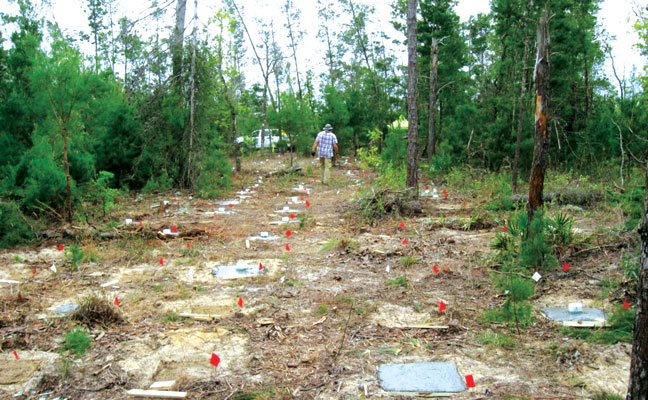
Completed ground board (bare soil with board and brick) and concrete slab (slab with PVC pipe) test at the Chipola Experimental Forest in March 2023. Plots with no PVC pipe or wooden boards are soil sampling plots. PHOTO: U.S. Department of Agriculture Forest Service
In 1998, our testing program began adding extra ground board and concrete slab plots for pesticide residue analysis at each concentration level of a newly installed product. One soil sample core per plot measuring 1 inch in diameter and 4 inches in length is collected both after initial installation and on each subsequent year of the study (see Fig. 3).
After the soil core is taken, a 1-inch diameter PVC spacer is placed in the exact sampling location to prevent the same place from being sampled again at a later date. The ground board and concrete slab plots designated for soil sample collection have no wood blocks in the plots and are not read for termite feeding. The collected soil samples are shipped to the product manufacturer for residue analysis of their product. Manufacturers can choose whether to analyze the samples. Results pertaining to soil sample residue analysis are not shared with the FS. For this reason, none of the soil sample data appear in the annual termiticide report.
The damage/feeding scales described are categorical and in nature, termite damage does not readily jump from one of these conditions to the next. Termite feeding would be more accurately represented if wood mass loss could be measured, but this is difficult to perform in the field in a short amount of time. The rating scale system allows for fast collection of damage data. In the field, the block ratings are also not evenly distributed across these categories. This is partly due to the size of the categories, with 3 taking up both a large portion of the potential block damage, as well as the largest chunk of study data each year for products reaching end of life date. Regardless, while it might be possible to make statistical comparisons using non-parametric methods, these are unnecessary as the standard established by the EPA is a pass/fail system. Furthermore, the categories can be important for state regulatory standards, which in some states can set percentages of allowable damage to blocks (see Performance Standards below).
Implemented program changes
In 2023, we adjusted the timing of plot reading and installation occurring at the Mississippi Harrison Experimental Forest test site to April, due to better weather conditions compared to June. Activity (finding termites on blocks or boards) might be slightly different between spring and summer in southern Mississippi, but regulatory decisions are made only on the block/board feeding rating. From this point forward, readings and installations at the Harrison Experimental Forest will occur in April.
Performance standards
Previous annual termiticide reports by the FS (see p. 52 of PMP’s April 2016 issue, and all earlier FS annual termiticide reports) have reported a single standard for federal registration under the EPA, under which each state can create its own standard. The individual state lead agencies for structural pest control make decisions regarding the use or sale of a product via either a state-specific regulatory standard — such as the Florida Termiticide Efficacy Rule, 5e-2.0311, FAC — or using their own judgment of the FS efficacy data on a product. Many state lead agencies choose to make these decisions collectively through the Association of Structural Pest Control Regulatory Officials (ASPCRO).
For the FS annual termiticide reports, the data in Tables 1 and 2 are presented for each testing site individually, as evaluated using the EPA guideline, and as an example of a state standard, the Florida Rule (individually by site and collectively across all southeastern sites). Discussions of the differences between the two standards have been covered in many of the past annual reports (see p. 52 of PMP’s April 2016 issue, and all earlier FS annual termiticide reports).
Latest test results
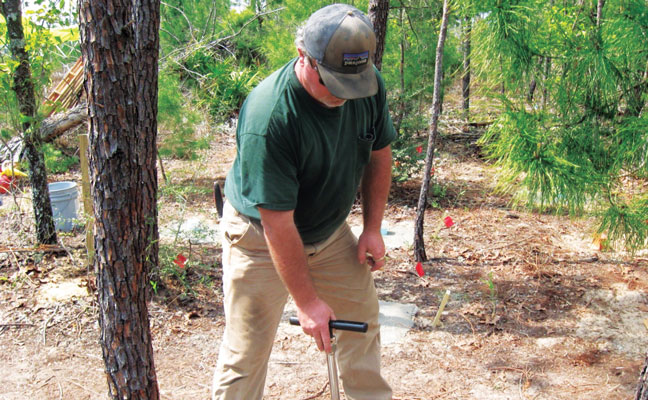
Soil samples are taken in a plot on the Chipola Experimental Forest. Photo: U.S. Department of Agriculture Forest Service
Data collected through 2022 for all repellent (Table 1) and non-repellent (Table 2) termiticides are found on p. 51 and p. 53. No new products entered the market in 2022, and all currently registered soil-applied termiticide products have had their studies closed at the request of their respective manufacturers. Thus, no new products whose data can be revealed are presented in this year’s report. The tables and data in this report are the same as the 2015 report (see p. 40 of PMP’s May 2015 issue). All recently collected data are for unregistered products, which remain confidential until after EPA registration.
A comment should be made regarding the Altriset product, with the active ingredient chlorantraniliprole. Altriset still appears in Table 2 because it retains its federal registration for use in the U.S. The product is no longer being produced by its manufacturer, Syngenta Crop Protection, but remaining stock still can be sold and applied. The data are provided here should the public need them when considering Altriset use. It is expected that the remaining stock will diminish over time and the product eventually can be removed from the table.
Personnel changes
This year, Dr. Grant Kirker from the FPL-4723 work unit in Madison, Wis., has been assisting with installation and readings. Dr. Kirker is quite experienced with the testing program. He completed his master’s degree while working at the FS termite unit in Starkville in 2004, and assisted with these studies for several years.
Conclusions
The USDA FS has provided unbiased candidate termiticide efficacy data for federal needs (military or regulatory) since 1938. The termiticide testing program has provided performance data to the EPA for all federally registered products. These data are also provided to PMPs and homeowners via this report.
We hope this information enables the public to make informed decisions regarding the protection of wood in service from termite attack and assists pest management companies in making decisions about which termiticide products to offer their customers.
Get to know the Gulfport scale
Termite damage data is assessed using the Gulfport scale: 0 = no damage; 1 = nibbles-to-surface etching; 2 = light damage with penetration; 3 = moderate damage; 4 = heavy damage; and 5 = board or block destroyed.
The Gulfport scale was developed in the late 1930s by the FS termiticide unit to give an estimate of the level of termite feeding on wood examined when the study plot is annually evaluated. The scale was first described and published in 1959 by Dr. Arthur Verrall (Verrall, 1959).
The Gulfport scale can be compared to other termite feeding standards such as the ASTM scale first described in standard D 3345-74 (ASTM, 1988). Below is a comparison of the two scales. Note that at one time ASTM added a 9.5 rating. That rating does not appear in the more recent version of this standard ASTM D 3345-22 (ASTM, 2022). Regardless, the 9.5 rating did not alter how the Gulfport scale converts, so 9.0 and 9.5 ASTM were both roughly equivalent to a Gulfport rating of 1.
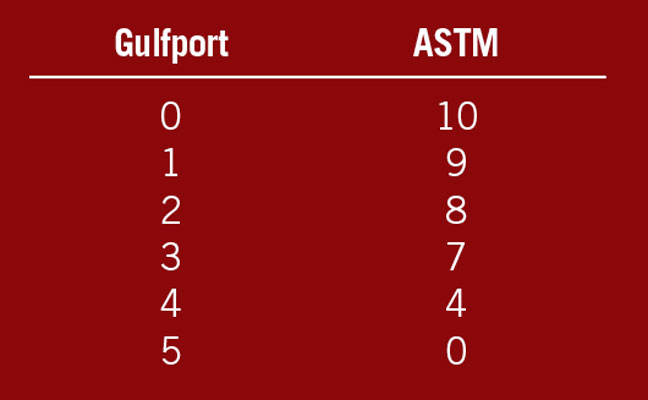
References
- ASTM (American Society for Testing and Materials). 2004. D3345-17. Standard test method for laboratory evaluation of wood and other cellulosic materials for resistance to termites. In: ASTM Annual Book of Standards, West Conshohocken, Pa.
- ASTM (American Society for Testing and Materials). 1988. D3345-74 Standard test method of laboratory evaluation of wood and other cellulosic materials for resistance to termites. In: ASTM Annual Book of Standards, West Conshohocken, Pa.
- Verrall, Arthur. 1959. Preservative moisture-repellent treatments for wooden packing boxes. Forest Products Journal. 9(1): 1-22.
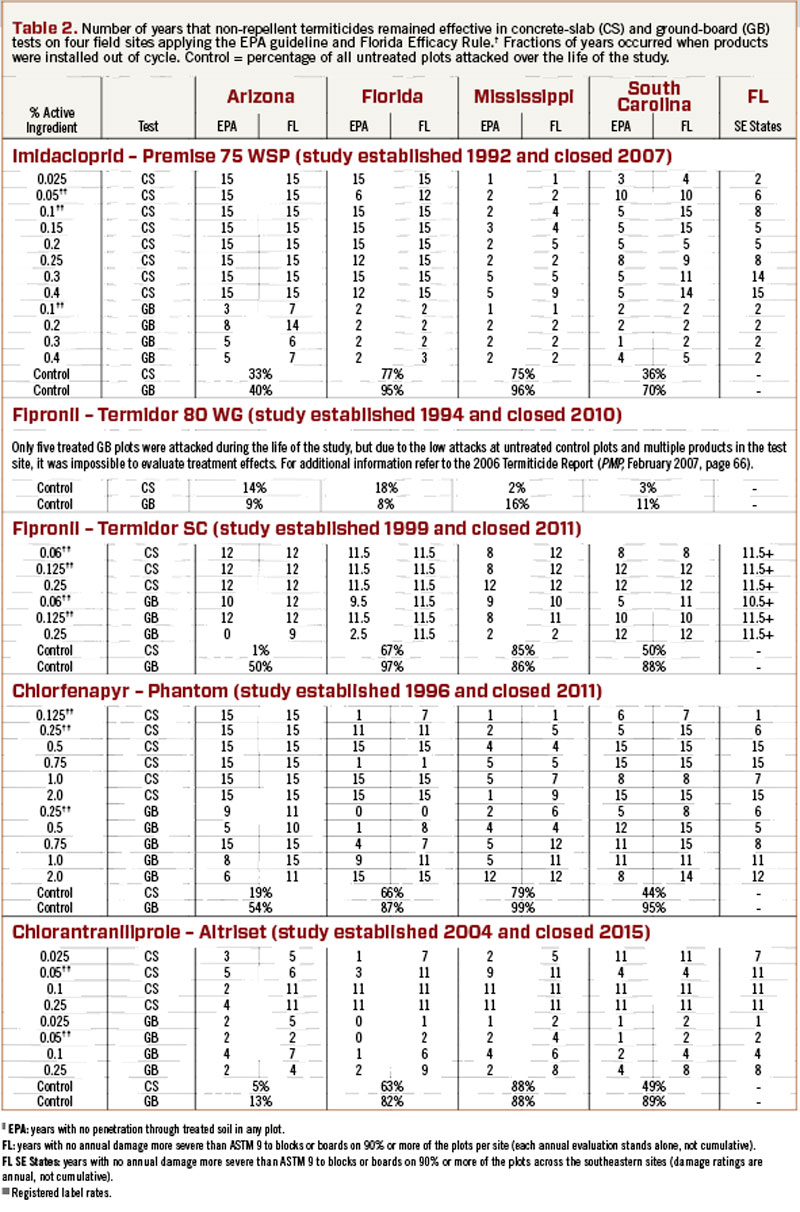
Leave A Comment